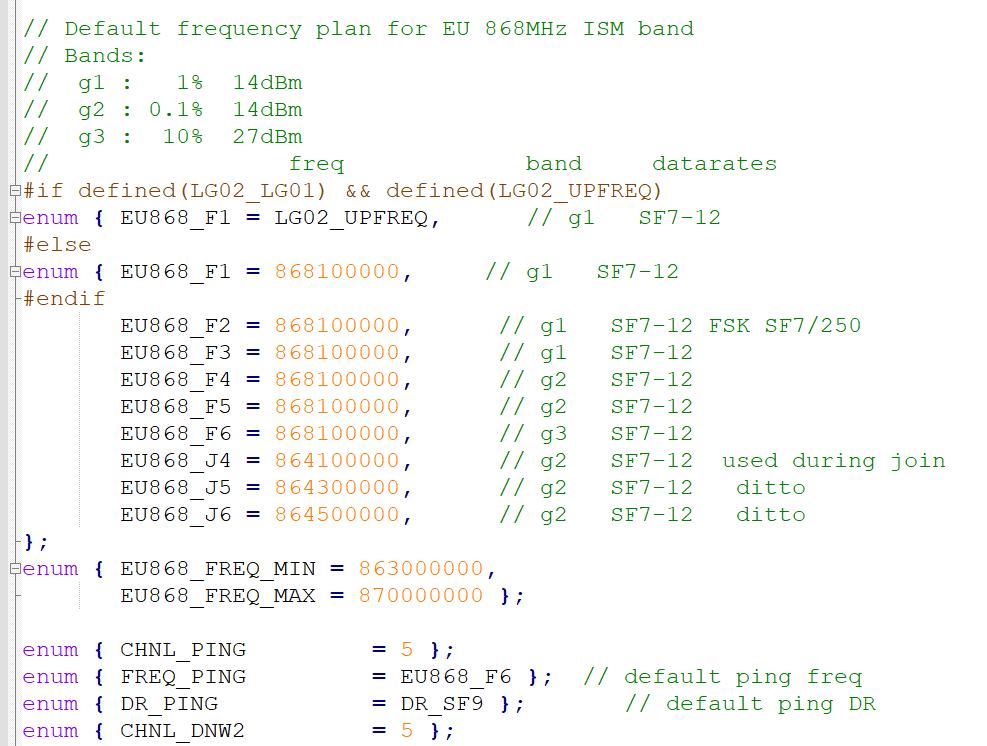Hi there,
I built a lorawan system by installing chirpstack architecture with a Lora shield from Dragino with Arduino mega and a lora gateway Lg01. I built a Lmic library for sending packets with Otaa activation method. The system was working fine and suddenly the device unable to Join to the Network server or The gateway does not receive any packets !!
Ihave attached a log read from Network server
I have a problem with packets ! somtimes the gateway received the packets and sometimes the packets got lost.
Although I donwloaded a lmic library from Dragino and I change the frequency plan for europe 868.1 Mhz to match my lora shield. The gateway is single channel and works on 868.1 MHZ
anyone can explain to me what is going on over here ?
thanx in advance
regards
Mohamad
here I attcahed pic from serial monitor. the device tries to join network
00:06:46.922 -> ######### Smart Plant from THM ####### COUNT=1 ###########
00:06:46.991 -> The temperature and humidity:
00:06:47.025 -> [24.00℃,59.00%]
00:06:47.060 -> moisture S1 is: 31
00:06:47.060 -> moisture S2 is: 41
00:06:47.094 -> moisture S3 is: 29
00:06:47.094 -> I Am Dry pls Water!!
00:06:47.129 -> Pump is ON
00:06:53.576 -> Britghtness is : 50 -Bright :
00:06:53.610 -> 1257644: engineUpdate, opmode=0x8
00:06:53.644 -> Packet queued
00:06:58.587 -> 1571170: EV_JOINING
00:06:58.621 -> 1571199: engineUpdate, opmode=0xc
00:06:58.656 -> 1571539: TXMODE, freq=868300000, len=23, SF=7, BW=125, CR=4/5, IH=0
00:07:13.653 -> 2509151: RXMODE_SINGLE, freq=868300000, SF=7, BW=125, CR=4/5, IH=0, rxsyms=255
00:07:23.686 -> 3134204: JaccRX1, dataLen=0
00:07:28.681 -> 3446784: RXMODE_SINGLE, freq=869525000, SF=12, BW=125, CR=4/5, IH=0, rxsyms=255
00:07:43.709 -> 4384346: JaccRX2, dataLen=0
00:07:48.716 -> 4696890: engineUpdate, opmode=0xc
00:08:08.701 -> 5946964: engineUpdate, opmode=0xc
00:08:08.736 -> 5947304: TXMODE, freq=868500000, len=23, SF=7, BW=125, CR=4/5, IH=0
00:08:23.736 -> 6884848: RXMODE_SINGLE, freq=868500000, SF=7, BW=125, CR=4/5, IH=0, rxsyms=255
00:08:33.774 -> 7509901: JaccRX1, dataLen=0
00:08:38.749 -> 7822481: RXMODE_SINGLE, freq=869525000, SF=12, BW=125, CR=4/5, IH=0, rxsyms=255
00:08:53.760 -> 8760042: JaccRX2, dataLen=0
00:08:58.790 -> 9072586: engineUpdate, opmode=0xc
00:09:23.797 -> 10635169: engineUpdate, opmode=0xc
00:09:23.831 -> 10635510: TXMODE, freq=868100000, len=23, SF=8, BW=125, CR=4/5, IH=0
00:09:38.829 -> 11573119: RXMODE_SINGLE, freq=868100000, SF=8, BW=125, CR=4/5, IH=0, rxsyms=255
00:09:48.861 -> 12198173: JaccRX1, dataLen=0
00:09:53.834 -> 12510754: RXMODE_SINGLE, freq=869525000, SF=12, BW=125, CR=4/5, IH=0, rxsyms=255
00:10:08.865 -> 13448319: JaccRX2, dataLen=0
00:10:13.875 -> 13760864: engineUpdate, opmode=0xc
00:11:28.875 -> 18448544: engineUpdate, opmode=0xc
00:11:28.909 -> 18448886: TXMODE, freq=868300000, len=23, SF=8, BW=125, CR=4/5, IH=0
00:11:43.914 -> 19386494: RXMODE_SINGLE, freq=868300000, SF=8, BW=125, CR=4/5, IH=0, rxsyms=255
00:11:53.939 -> 20011549: JaccRX1, dataLen=0
00:11:58.935 -> 20324129: RXMODE_SINGLE, freq=869525000, SF=12, BW=125, CR=4/5, IH=0, rxsyms=255
00:12:13.944 -> 21261694: JaccRX2, dataLen=0
00:12:18.939 -> 21574239: engineUpdate, opmode=0xc
00:13:28.976 -> 25949410: engineUpdate, opmode=0xc
00:13:29.010 -> 25949752: TXMODE, freq=868500000, len=23, SF=9, BW=125, CR=4/5, IH=0
00:13:44.009 -> 26887360: RXMODE_SINGLE, freq=868500000, SF=9, BW=125, CR=4/5, IH=0, rxsyms=255
00:13:54.019 -> 27512414: JaccRX1, dataLen=0
00:13:59.030 -> 27824995: RXMODE_SINGLE, freq=869525000, SF=12, BW=125, CR=4/5, IH=0, rxsyms=255
00:14:14.042 -> 28762560: JaccRX2, dataLen=0
00:14:19.046 -> 29075188: engineUpdate, opmode=0xc
00:17:09.059 -> 39700548: engineUpdate, opmode=0xc
00:17:09.093 -> 39700889: TXMODE, freq=868100000, len=23, SF=9, BW=125, CR=4/5, IH=0
00:17:24.107 -> 40638498: RXMODE_SINGLE, freq=868100000, SF=9, BW=125, CR=4/5, IH=0, rxsyms=255
00:17:34.105 -> 41263554: JaccRX1, dataLen=0
00:17:39.111 -> 41576134: RXMODE_SINGLE, freq=869525000, SF=12, BW=125, CR=4/5, IH=0, rxsyms=255
00:17:54.127 -> 42513698: JaccRX2, dataLen=0
00:17:59.157 -> 42826244: engineUpdate, opmode=0xc
00:20:54.165 -> 53764112: engineUpdate, opmode=0xc
00:20:54.200 -> 53764454: TXMODE, freq=868300000, len=23, SF=10, BW=125, CR=4/5, IH=0
00:21:09.208 -> 54702000: RXMODE_SINGLE, freq=868300000, SF=10, BW=125, CR=4/5, IH=0, rxsyms=255
00:21:19.234 -> 55327056: JaccRX1, dataLen=0
00:21:24.217 -> 55639636: RXMODE_SINGLE, freq=869525000, SF=12, BW=125, CR=4/5, IH=0, rxsyms=255
00:21:39.237 -> 56577200: JaccRX2, dataLen=0
00:21:44.244 -> 56889745: engineUpdate, opmode=0xc










 LoRa!=LoRaWAN. The difference is similar to saying 802.11 vs WiFi, one is the physical link taking care of the RF signal, the other the network layer (roughly), taking care of addresses, encryption, etc.
LoRa!=LoRaWAN. The difference is similar to saying 802.11 vs WiFi, one is the physical link taking care of the RF signal, the other the network layer (roughly), taking care of addresses, encryption, etc.